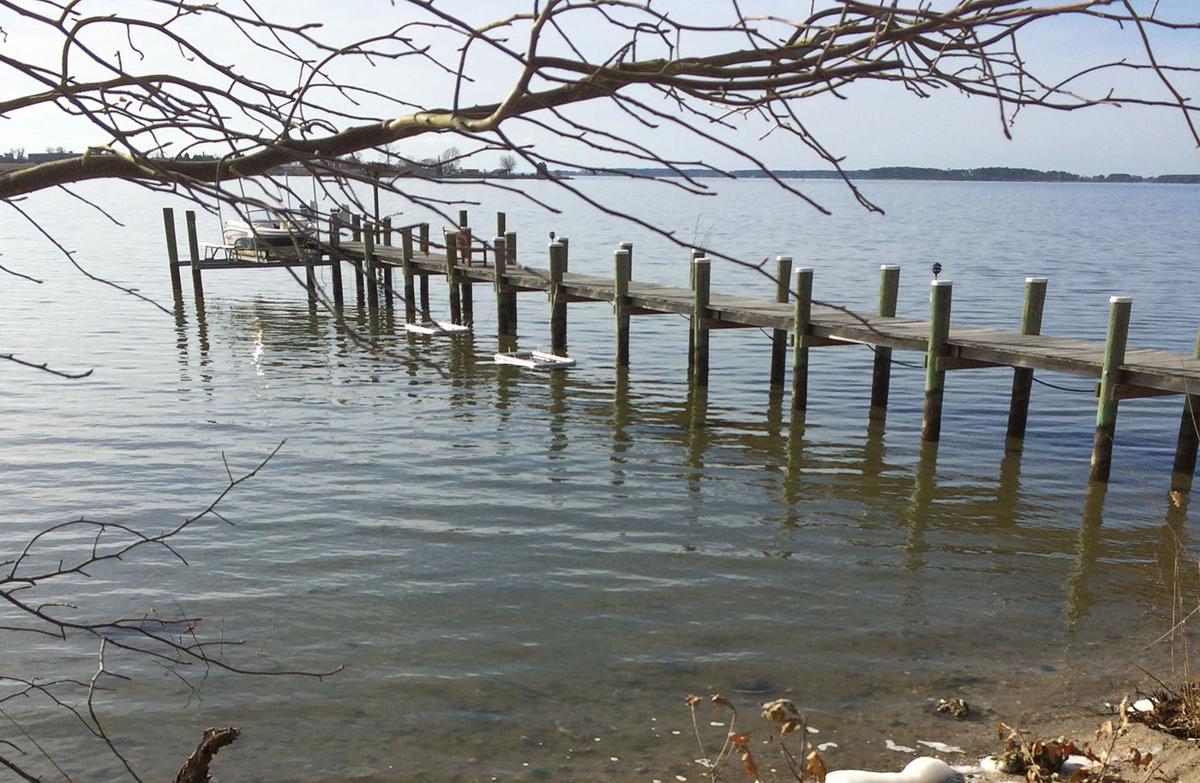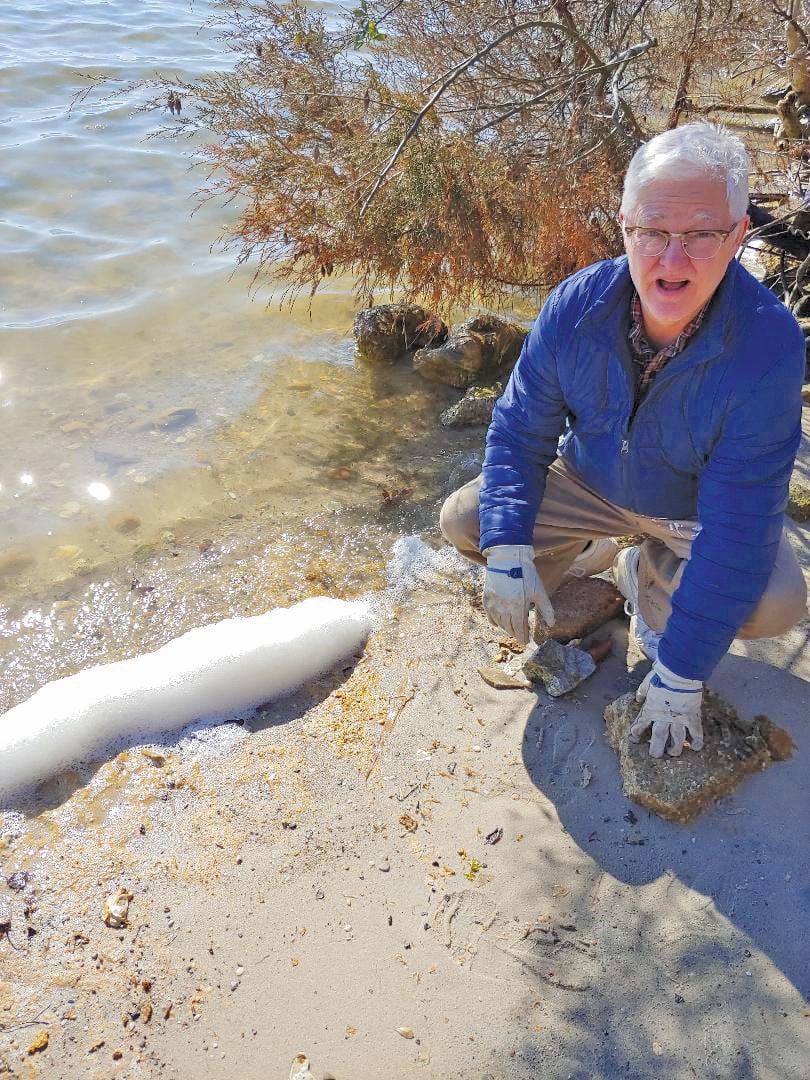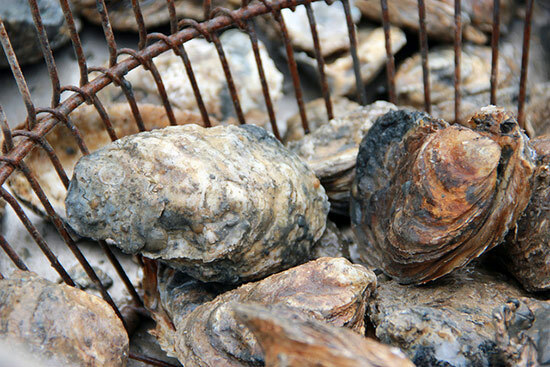
A water sample that a local resident collected from St. Inigoes Creek in Southern Maryland contained elevated levels of PFAS, a family of “forever chemicals” that have caused widespread contamination. Courtesy of Pat Elder
Maryland to Test Water, Oysters in St. Mary’s River for Toxic Chemicals
Timothy B. Wheeler / The Southern Maryland Chronicle
(April 7, 2020) — Maryland officials say they plan to test a Chesapeake Bay tributary and oysters in St. Mary’s County after a local resident found high levels of toxic chemicals in his tidal creek — a category of contaminants that have been traced to military and industrial sites nationwide.
Lee Currey, director of the water and science administration for the state Department of the Environment, said the agency intends to sample surface water and oyster tissue in the St. Mary’s River watershed for per– and poly-fluoroalkyl substances, or PFAS. The agency had hoped to begin by April and have results by May, but an MDE [Maryland Department of the Environment] spokesman said sampling has been delayed because fieldwork has been suspended by the coronavirus pandemic.
A water sample that a local resident collected from St. Inigoes Creek in Southern Maryland contained elevated levels of PFAS, a family of “forever chemicals” that have caused widespread contamination. Courtesy of Pat Elder
“It is a priority for us,” said MDE Secretary Ben Grumbles. He noted that he had formed an internal agency-wide task force to deal with PFAS, which are among the most widely used and persistent chemicals in the world. They have increasingly turned up as a contaminant practically everywhere — in air, water, soil, food and even people’s bodies.
PFAS don’t readily break down in the environment, which has earned them the nickname “forever chemicals.” They are a family of more than 4,000 chemicals that have been used in a wide variety of products, such as food packaging, stain- and water-repellent fabrics and nonstick coatings on cookware. They are also used in fire-fighting foam, which has left contamination at hundreds of airports, military bases and firefighting training sites.
PFAS have been found in groundwater, streams and drinking water supplies in nearly 1,500 places nationwide, including about four dozen sites in the six-state Bay watershed.
Most detections have been at very low levels, but a number of sites exceed the lifetime exposure level recommended by the U.S. Environmental Protection Agency for drinking water, including some in the Bay region.

Pat Elder kneels on the shoreline of St. Inigoes Creek in Maryland, where he collected a water sample that contained PFAS. The foam in photo is most likely a natural byproduct of wind and wave action. Courtesy of Pat Elder
Pat Elder, the St. Mary’s County resident who reported finding PFAS in St. Inigoes Creek in front of his home, said he was glad the MDE was responding. He is a peace activist who’s been working to raise awareness about toxic contamination around military bases. Using a testing kit he bought from a Michigan environmental group, he collected water from the creek earlier this year and had it analyzed by a laboratory in that state.
“My wife prompted me,” Elder said. “She said, ‘Why don’t we get our water tested?’?”
St. Inigoes Creek is a tributary of the St. Mary’s River. Across from Elder’s home is Webster Field, a naval air research facility with a small airfield. It’s an annex to Naval Air Station Patuxent River, the sprawling base about a dozen miles away.
Webster Field’s 1,000-acre site includes a fire station. Fire-fighting foam containing PFAS was sprayed there years ago, according to Lance McDaniel, environmental director for NAS Patuxent River.
The lab that analyzed Elder’s water sample found 14 different PFAS compounds with a total concentration of 1,894 parts per trillion of water. That’s 27 times the EPA’s recommended safety limit for drinking water. St. Inigoes Creek is not a source of drinking water, but Elder questions whether oysters harvested from the creek and river are safe to eat.
Health effects of ingesting PFAS haven’t been thoroughly researched, but the most frequently studied compounds, including the type used in fire-fighting, have been found to interfere with the body’s natural hormones, increase cholesterol levels, affect the immune system and raise the risk for some cancers.
PFAS have been found in oysters in China and New Hampshire, among other places, and even in St. Mary’s County nearly two decades ago. A 2002 study detected seemingly significant levels in oysters along the Gulf Coast and in Maryland at Hog Point at the mouth of the Patuxent River — at the northern tip of the naval air station. That study drew little attention and elicited no followup.
Elder said he tried, initially without success, to get local or state officials to take his test result seriously.
But Bob Lewis, executive director of the St. Mary’s Watershed Association, found Elder’s test results alarming and posted them on the group’s website in February. Lewis said he didn’t want to overreact, because the Navy said the lab Elder used was not certified to test for PFAS. But he said the results raised questions that called for answers.
“I don’t know how to quantify all this,” he said, but the level reported by the Michigan lab “sounds like it’s a problem.”
On March 3, more than 275 people showed up for an open house the Navy held to explain its plans for investigating PFAS contamination at the naval air station. Many wanted to know what was being done in response to Elder’s test results. They left frustrated.
The Navy and its contractors presented plans to test ground water in 18 spots on the base. But David Steckler, who runs environmental restoration efforts at the naval air station, said there were no immediate plans to sample outside the fence line because there was no evidence of contamination moving off-site through ground water. No information was presented about Webster Field.

Has the US Navy been poisoning Chesapeake Bay’s oysters?
“I think the Navy did a pretty good job of assuring people there’s no threat to the drinking water supply,” Lewis said. But, he added, “They didn’t do anything to assure people about open water and aquatic animals.”
Navy officials say they welcome MDE’s testing plans. “Any opportunity to learn more about these compounds is a benefit to the public and the scientific community,” McDaniel, the base’s environmental director, said in an email. He said the Navy is focusing its investigation “on our installations where we have already identified releases.”
That includes two locations at Webster Field. He said that former base personnel had identified an area at the airfield where foam was sprayed and, as a precaution, the fire station on base would also be checked.
Runoff from Webster Field is collected and discharged into the St. Mary’s River below St. Inigoes Creek, as is treated wastewater from the facilities on the base, according to McDaniel. The MDE plans to sample water in the creek as well as in the river above and below the creek.
Ira May, who oversees federal site cleanups for the MDE, suggested that contamination in the creek, if it exists, could have another source. The chemicals are often found in landfills, he noted, as well as in biosolids and at sites where civilian fire departments sprayed foam.
“So, there are multiple potential sources,” May said. “We’re just at the beginning of looking at all of those.”
Kathy Brohawn, chief of the MDE’s public health section, said the agency plans to sample oysters in the creek, as well as above and below it in the river. The agency also “tentatively” plans to test oysters at Hog Point, she said.
J.D. Blackwell, who raises oysters in St. Mary’s County waters, doesn’t think any of his leases there are close enough to the military sites to be at risk of contamination.
“I don’t think eating my oysters or oysters off most public waters presents an elevated risk,” he said. “But I do wonder if [oyster] bars and leases adjacent to bases are a problem.” And, he said, “if there’s a problem, I want to know it.”
Elder voiced no regrets about stirring public concern with his own test of the water, which he dubbed “guerilla science.”
“Call me a gumshoe or whatever,” he said, “but at least it’ll get some action.”
He noted that other states, such as New Jersey and Michigan, have already tested their fish and shellfish and set fish consumption advisories.
“It’s about protecting public health,” he said. “They’re years ahead of Maryland.”
Currey said the surface water and oyster testing are part of a broader approach to PFAS. The agency is finalizing a statewide survey for sites where the chemicals may have been used, and regulators will focus on investigating and remediating any sites with risks of significant human exposure.
The MDE’s Grumbles acknowledged the public anxiety in St. Mary’s County.
“Every person who’s aware of a potential risk wants to get real information and understand the extent of the risk or if it’s a false positive,” he said. “We share the concern and we’re committed to following through.”
The Southern Maryland Chronicle is a local, small business entrusted to provide factual, unbiased reporting to the Southern Maryland Community. We never want to make the Chronicle a “pay-wall” style news site. — David M. Higgins II davidhiggins@southernmarylandchronicle.com
© 2019 The Southern Maryland Chronicle. All Rights Reserved. This website is not intended for users located within the European Economic Area. Posted in accordance with Title 17, Section 107, US Code, for noncommercial, educational purposes.